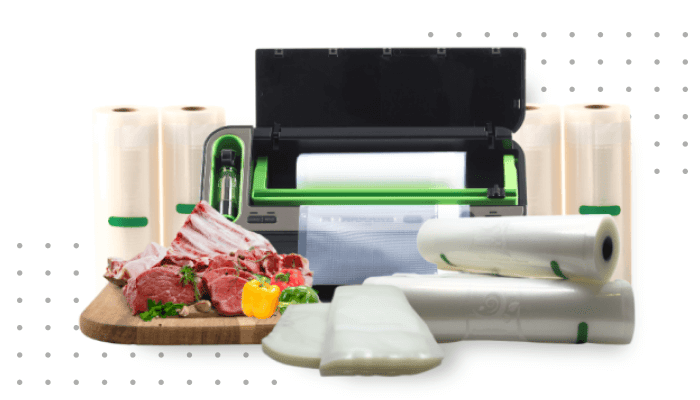local_shipping Free shipping * Orders Above $50 $50+
star Reviews Help keyboard_arrow_down Account keyboard_arrow_down-
New customer?
Create account
local_shipping Free shipping * Orders Above $50
Free shipping for Orders above $50
Products
Help
My Account
Reviews
Vacuum Sealing Tips & Problem Solving - OutOfAir
How to Ensure Your Bags Will Seal and Stay Sealed
First, let's talk about WHY bags fail.
There are basically only 3 reasons a vacuum sealer bag will fail:
- The seal line area was dirty/wet/wrinkled when the bag was sealed or made (if made from a roll).
- Something in the bag punctured the bag.
- The bag is defective.
Ok, now let's talk about how to resolve these problems to ensure your bags seal and stay sealed!
Keeping the Seal Area Clean and Wrinkle Free
If the seal area is dirty, wet, or wrinkled your machine will have a difficult time forming a proper seal. The way the machine seals the bag is by heating up the plastic to fuse the inner layers together. But if anything is in the way, the two sides of the bag can't touch and won't seal.
We have a few suggestions below, feel free to use one or multiple of these suggestions.
- Fold the top 1.5-2 inches of the bag up and out of the bag. This will give you some room to put food in to the bag without it getting all over the seal area. See the images below for an example.
-
If you are sealing food that has juice or sauce, or it could be easily crushed -
FREEZE it first.
We know, this doesn't seem right - you are trying to prevent freezer burn after all right?
Not to worry - this won't damage your food. What you want to do is bag your food, then freeze it just long enough for it to be semi-solid to solid. At most this is usually 4-8 hours (overnight). Before putting the bags in the freezer we recommend filling your bags, then folding the top of the bag over 1-3 times and placing a (non-sharp) clip on the bag to keep it sealed.
After that you can safely vacuum seal it without any of the juices being sucked out. This keeps your food tasting better when you later defrost it, and it also prevents problems you may run in to when sealing the bags.
-
Sometimes when filling your bags, especially if you fill them up high - it can cause wrinkles in the bag. Also, all rolls will have SOME wrinkles as you reach the end of the roll (this goes for all brands).
What you want to do to prevent this from causing a problem is to pull the bag taut while closing your machine (or while the machine is engaging it's automatic clamp). - If sealing something sharp, for example bone-in meats you may want to add extra plastic where the sharp edges may contact bags. You can double bag, or use a cut portion of a separate bag/roll for this. Another option would be to use a folded piece of wax paper or even a paper towel to cover the sharp edges (we recommend using the tips above to freeze before you do this if using a paper towel - that way the paper towel doesn't get stuck to the meat).
-
If sealing dried meats (like beef jerky) or fruits the best thing you can do is use
oxygen absorbers.
Important Note About Oxygen and Oxygen Absorbers
When vacuum sealing, although you're removing air from your bags - the real problem is not the air, but the oxygen in the air which causes food to go bad. Air is made up only about 21% oxygen (the rest of air is mostly nitrogen, and some other gases). Oxygen absorbers will absorb oxygen, but your bags won't get any tighter when using them because there will still be those other gases, but that's ok because those other gases don't harm your food.
When using oxygen absorbers you would bag your food, put an oxygen absorber in the bag, then vacuum seal the bag - BUT you want to manually control when the bag seals. If you have a pulse function on your machine this makes it much easier. You want to seal the bags once the majority of the air has been removed, but before the machine has tightened down. Stopping it here will leave just a small amount of air in the bags. The oxygen absorbers will take care of the left over oxygen in the bag.
Preventing Punctures
Defective Bags
We do our best to prevent defects, but every now and then defects can happen. We're not perfect, we just keep trying to be. If you think you bought defective bags from us, please contact us right away. We'll likely want to receive the defective bags back for testing - just in case it's a problem that could affect other customers (we will provide a free mailing label for you to send them in to us for testing), and we'll of course get you a replacement!
 Vacuum Sealer Bags & Rolls for Food Savers (Free Shipping)
Vacuum Sealer Bags & Rolls for Food Savers (Free Shipping)




